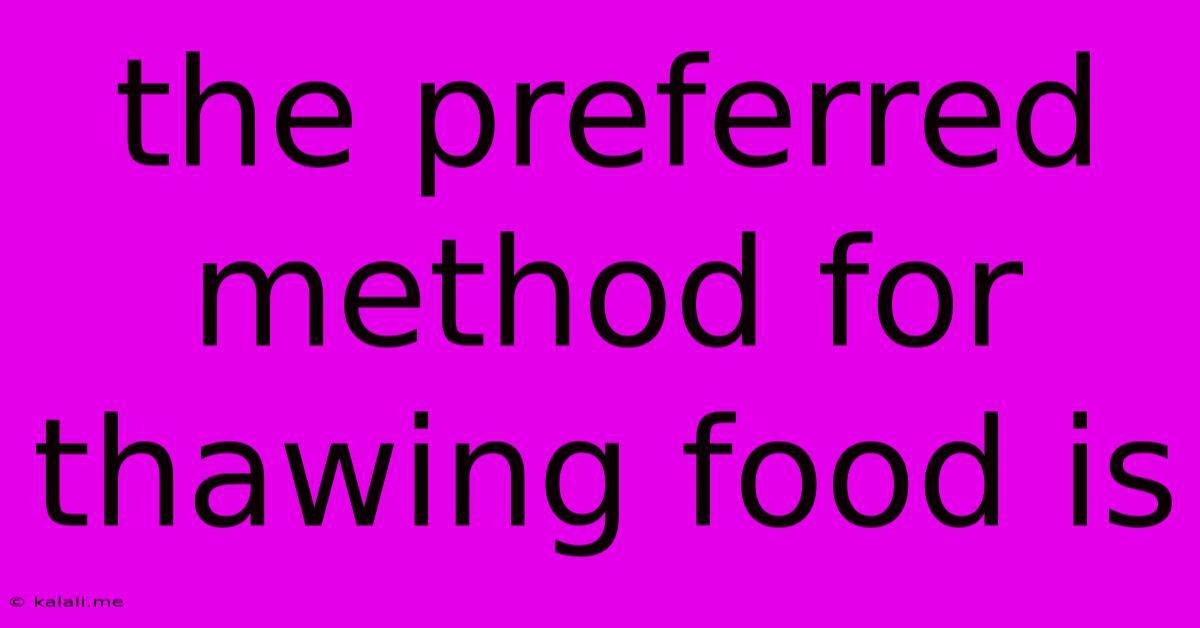The Preferred Method For Thawing Food Is
Kalali
Jun 15, 2025 · 3 min read

Table of Contents
The Preferred Method for Thawing Food: Safety and Efficiency
Thawing frozen food safely and efficiently is crucial for food safety and preventing the growth of harmful bacteria. While there are several methods, some are significantly safer and more efficient than others. This article will explore the best practices for thawing food, highlighting the preferred method and addressing common misconceptions.
Why Safe Thawing Matters:
Improperly thawed food can harbor dangerous bacteria like Salmonella, Listeria, and E. coli. These bacteria thrive in the "danger zone," the temperature range between 40°F (4°C) and 140°F (60°C). Leaving food at room temperature for extended periods allows bacteria to multiply rapidly, increasing the risk of foodborne illness. Understanding the safest thawing methods is essential to protect your health and the health of your family.
The Preferred Method: Refrigeration
The safest and most recommended method for thawing frozen food is refrigeration. This slow, controlled process minimizes the risk of bacterial growth. Simply transfer the frozen food from the freezer to the refrigerator and allow it to thaw completely. The thawing time will depend on the size and type of food, but it typically takes several hours or even overnight for larger items.
Advantages of Refrigerator Thawing:
- Safety: The consistently cold temperature of the refrigerator inhibits bacterial growth.
- Convenience: You can plan ahead and thaw food overnight, ensuring it's ready when you need it.
- Food Quality: Slow thawing helps maintain the texture and quality of the food.
Other Safe Thawing Methods:
While refrigeration is the preferred method, other safe options exist, provided they're executed correctly:
-
Cold Water Thawing: This method involves placing the food in a leak-proof bag and submerging it in cold water, changing the water every 30 minutes to maintain a consistent cold temperature. This method is faster than refrigeration but still prevents bacterial growth. Always ensure the food remains submerged and the water is cold.
-
Microwave Thawing: Microwaves can thaw food quickly, but it's crucial to cook the food immediately after thawing to avoid bacterial growth. Many microwaves have a defrost setting specifically designed for this purpose. Follow the manufacturer's instructions carefully.
Methods to Avoid:
-
Room Temperature Thawing: Never thaw food at room temperature. This is the riskiest method, allowing bacteria to multiply rapidly and significantly increasing the chance of food poisoning.
-
Hot Water Thawing: Using hot water to thaw food can lead to uneven thawing and increased risk of bacterial growth in certain areas.
Tips for Safe Thawing:
- Plan Ahead: Thaw food in the refrigerator well in advance to avoid rushing the process.
- Check the Temperature: Use a food thermometer to ensure the food has reached a safe internal temperature before consumption.
- Cook Thoroughly: Cook thawed food immediately or within 24 hours of thawing to prevent bacterial growth.
- Don't Refreeze: Once thawed, food should not be refrozen unless it has been cooked to a safe temperature.
By following these guidelines and prioritizing refrigeration as your primary thawing method, you can ensure the safety and quality of your food while minimizing the risk of foodborne illnesses. Remember, safe food handling practices are crucial for maintaining good health.
Latest Posts
Latest Posts
-
Price Discrimination Is Only Possible When
Jun 15, 2025
-
A Transformer Is A Device That Normally
Jun 15, 2025
-
The Largest Lymphatic Organ In The Body
Jun 15, 2025
-
Pittsburgh Institute Of Mortuary Science Cost
Jun 15, 2025
-
What Is The Factors Of 33
Jun 15, 2025
Related Post
Thank you for visiting our website which covers about The Preferred Method For Thawing Food Is . We hope the information provided has been useful to you. Feel free to contact us if you have any questions or need further assistance. See you next time and don't miss to bookmark.